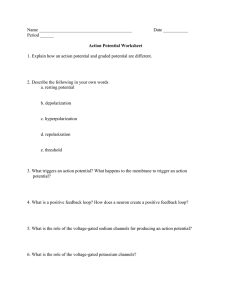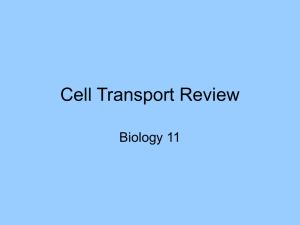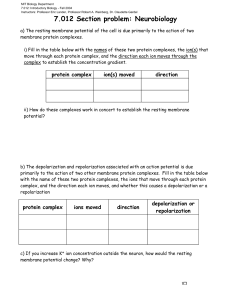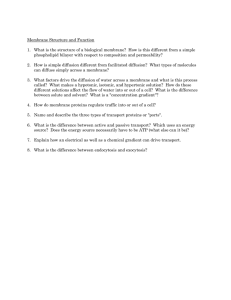CMB710 Lecture #2
advertisement
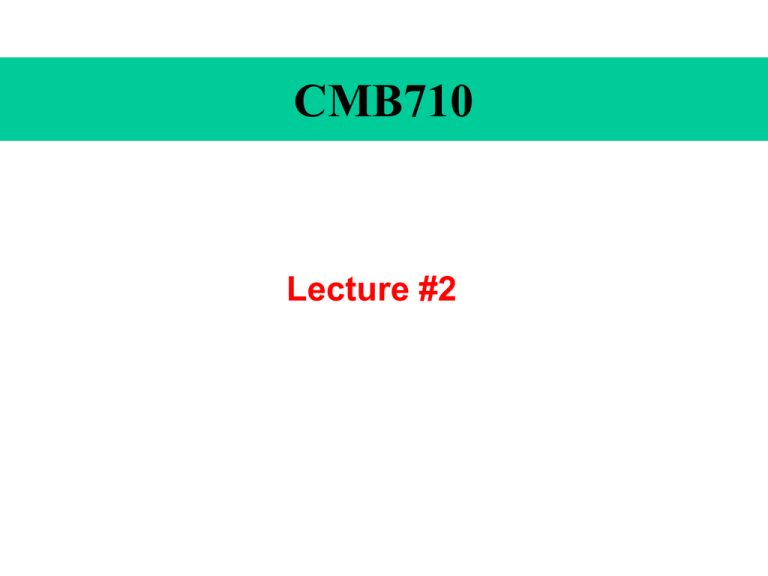
CMB710 Lecture #2 Membrane Potentials • Resting and Action Potentials can be understood in terms of ion gradients, the Nernst equilibrium, and ion channels. Ionic Gradients Table 11-1 Cytoplasm Serum mM Na+ K+ Ca2+ H+ Cl- 5-15 140 1x10-4 10-7.2 5-15 145 5 1-2 10-7.4 110 Charged solutes • A quick review of electricity. • Charge is something that particles can have as either + or -. • Charged particles exert a force on each other. • Current is the movement of charge (coulombs/sec), a flux of charge. • The voltage difference between two points is the work (force x distance) required to move a charge from one point to the other. • In the upper panel, point A is relatively negative to point B. The voltagedifference VB-A>0 • In the lower panel, point A is relatively positive to point B, VB-A<0 • Whereas uncharged solutes diffuse in response to a concentration gradient, charged solutes will diffuse in response to concentration and voltage gradients. There are two forces acting on a given ionic species. 1. Chemical gradients: The chemical concentration gradient tends to move ions down this gradient. 2. Electrical gradients: The electrostatic force due to the charge separation across the membrane tends to move ions in a direction determined by its particular charge. MBOC 11-4 (modified) • • • • Panel A: concentration gradient but no voltage gradient. Easy, diffusion down concentration gradient. Panel B: concentration and voltage gradient in the same direction. Easy, diffusion down both gradients. Panel C: concentration and voltage gradients oppose each other. Not so easy. Here the concentration gradient has more energy. Diffusion down concentration gradient but up voltage gradient. Panel D: concentration and voltage gradients oppose each other. Not so easy. Here the voltage gradient has more energy. (Note fewer dots above membrane.) Diffusion down voltage gradient but up concentration gradient • We now consider a quantitative understanding. • My sample is Cl- because the physiological gradients for Cl- are trickier than those for Na+, K+, and Ca2+. Nernst Equation • The physiological gradients in the previous slide can be evaluated using the Nernst equation that describes voltage and concentration gradients that have the same energy. Voltage Gradient RT [Cl ]o ECl ln zF [Cl ]i Equal Sign Concentration gradient [Cl ]o RT [Cl ]o 60 110 ECl ln log 60 log 62mV zF [Cl ]i z [Cl ]i 10 E= equlibrium potential R= gas constant T= absolute temperature F= faraday constant Z= the valence of the ion [C]o and [C]I= outside and inside concentration The Nernst equilibrium. • The concentration gradient and the voltage gradient have the same energy. They oppose each other. • The net gradient is nil. • No energy change as Clmoves left to right or right to left. DG=0 • If 62 mV has the same energy as a 110 to 10 mM gradient, 70 mV has more energy. Here the voltage gradient dominates. • Passive flux of Cl- out of the cell. • Passive flux of Clinto the cell. • Here Cl- passively leaks in to the cell and is actively transported out of the cell (Na+-driven Cl- -HCO3exchanger). EK=60log10[5]/[140]=-87mV See next slides for explanation. in K+ 140mM out 5mM EK=60log10[5]/[140]=-87mV -87mV -60mV -40mV -100mV Example: external high K+ and low K+ Membrane Potential • Start with the Resting Potential • Advance to the Action Potential I. Resting Potential • The membrane potential is critical for maintenance of the integrity of the cell membrane including the protein complexes within the lipid bilayer, and for signal transduction in excitable cells such as nerve and muscle. To understand how nerves conduct information or how muscles are induced to contract, one must first understand the origin of the membrane potential. • All cells have a negative resting potential. Generation of resting membrane potential: What is the mechanism that generates the –67 mV resting potential? • Large negatively charged molecules inside the cell too large to pass through • K+ leaks out easier (leaves a positive charge outside) • Na - K exchange pump brings in 2 K+ and expels 3 Na+ (again leaves a positive charge outside) a. + + Na -K Pump • ATPADP+Pi is the power source (against electrochemical gradients). • 3Na+ out plus 2 K+ in per ATP (Osmolarity) • Net transfer of positive charge out of cell and thus contribute RMP (around 10% of electrical negativity inside cell) Since , by convention, the potential outside the cell is arbitrarily defined as zero, and given the relative excess of negative charges inside the membrane; the potential difference across the membrane is expressed as a negative value. • With the probes outside of the cell there is no voltage-difference. • Poking one probe into the cytoplasm reveals (in this cell) a –67 mV resting potential. Cytoplasm negative relative to extracellular. • Since only K+ moves we can ignore the other ions in the cartoons. • Calculate EK? EK=60log10[5]/[140]=-87mV • What are the transmembrane potentials in each case? • The potential in A is –87 mV. • The potential in B is +87 mV. • The potential in C is 0 mV. • In the approximation the membrane was perfectly selective. Only K+ got across and only K+ set up the resting potential. It is a K+ electrode. • In a real membrane the other ions have finite permeabilities and all ions contribute to the resting potential. • In real cells the ions are generally not at equilibrium. They passively leak in or out of the cell and are actively pumped to maintain steady state gradients. – – – – – K+ leaks out and is pumped in Na+ leaks in and is pumped out Sometimes Cl- leaks in / pumped out Sometimes Cl- leaks out / pumped in Sometimes at equilibrium! • Each ion gradient contributes its Nernst equilibrium potential to the resting potential. • The contribution is weighted such that ions with higher relative permeabilities contribute more. – If PK>>PNa and PCl then the potential will be near EK •High permeability indicates that particle mass moves easily through a membrane. • High conductance indicates that electrical charge moves easily through a membrane. • Conductance is the inverse of electrical resistance. If the conductance of the membrane to a particular ion is low, then the resistance to movement of that ion across the membrane is high. Goldman, Hodgkin, Katz (GHK) equation •The Goldman, Hodgkin, Katz (GHK) equation is a quantitative and unambiguous version of the previous slide. RT PK [ K ]o PNa [ Na]o PCl [Cl ]i Em ln F PK [ K ]i PNa [ Na]i PCl [Cl ]o • The GHK equation incorporates only three ions. – These turn out to be the important ones. – Permeabilities for the others are much smaller than PK, PNa and PCl so they can be ignored. – The equation holds only for monovalents. Modification to include divalents is not trivial. • An Excel spreadsheet will help with these goals. ion K Na Cl intra 140 5 145 extra 5 140 145 Rel. Perm. 1 0.01 0.032 Ex -86.8 86.8 0.0 Em -67.0 Here is one set of permeabilities that will achieve a resting potential of –67 mV from our sample gradients. • Note the relatively negative ECl and high PCl ion K Na Cl intra 140 7 10 extra 5 145 110 Rel. Perm. 1 0.02 0.4 Ex -86.8 79.0 -62.5 Em -71.4 The Action Potential • Many cells manipulate membrane potential. – Skeletal, cardiac, smooth muscle – Neurons – Endocrine cells. • Activates contraction or secretion. • The signal travels quickly along long cells. 60 60 µA 40 30 µA depolarization mV 20 0 repolarization -20 -40 -60 0 60 2 4 6 8 10 msec µA 30 0 • An action potential is a transient depolarization from the normal resting negative membrane potential. • Properties vary from cell to cell – A few ms to a few seconds (action potential duration) – 20 to 120 mV in amplitude (action potential amplitude) – Evoked by stimulation or spontaneous • We will use the action potential of the giant axon of the squid as our model. – Very much like mammalian axons – Fewer kinds of channels than in cardiac muscle, smooth muscle, and neurons. Who were Hodgkin and Huxley? Hodgkin and Huxley were two British electrophysiologists who did voltage clamp experiments on the squid giant axon in the 1940s and 1950s. Based on this experimental work they developed a mathematical model of how Na+ and K+ conductances depend on voltage and time. In 1952, they published a key paper with a full quantitative model for the ionic basis of the action potential in squid axon. The HodgkinHuxley model is still in use today. Hodgkin and Huxley were awarded the Nobel Prize for their work in 1963. • The figure shows the experiment. One electrode records membrane potential. One electrode injects charge (current in µA) • Injection of + charge (as shown) will make the membrane potential less negative. DEPOLARIZATION • Injection of – charge will make the membrane potential more negative. HYPERPOLARIZATION Current injection RMP (-90mV) Depolarization (e.g.from –90 to –70mV) mV hyperpolarization (e.g.from –90 to –100 mV) Three basic properties of action potentials. 1. Threshold (“all or none”) 2. Refractory period 3. Conduction 1. Threshold • Injections of small amounts of current result in small shifts in membrane potential. • When the injection stops, the membrane potential recovers more or less directly to the resting potential. potential -8 µA current injection • -8 µA causes a peak hyperpolarization of about 11 mV potential -4 µA current injection • -4 µA causes a peak hyperpolarization of about 6 mV potential -2 µA current injection • -2 µA causes a peak hyperpolarization of about 3 mV potential +2 µA current injection • +2 µA causes a peak depolarization of about 3 mV potential +4 µA current injection • +4 µA causes a peak depolarization of about 6 mV. Note the slower recovery. potential +8 µA current injection • +8 µA causes a peak depolarization of about 93 mV. This is different… potential +16 µA current injection • +16 µA causes a peak depolarization of about 97 mV. About the same (supramaximal stimulation). • Stimuli that fail to elicit an action potential are “subthreshold”. • Stimuli that elicit an action potential are “suprathreshold”. • Action potentials are (nearly) independent of the stimulus. – This is characterized as “all or none”, you either get an action potential or you don’t. All or none principle Stimuli either fails or elicit action potentials or produce full-size action potentials Mechanism of the AP • As noted earlier, there are a lot of channels that can set membrane permeability. The giant axon of the squid uses only three. – K+ leak channels (major conductance during resting state) – Voltage-gated Na+ channels (during onset of AP, 500 fold increase in Na+ conductance) – Voltage-gated K+ channels (opening slowly after Na+ channel open) • Other cells will use many kinds of channels. Dozens. Even more?? (Ca2+ channels in heart) Mammalian cell ion K Na Cl intra 140 7 10 extra 5 145 110 Ex -86.8 79.0 -62.5 Squid axon ion K Na intra 440 50 extra 10 440 Ex -98.6 56.7 • Recall the ion gradients and the Nernst equilibrium potential. • The resting potential is set by the K+ leak channels. – PK>PNa 60 ENa channels 40 30 µA 20 mV Opening Na+ 60 µA 0 Opening K+ channels -20 -40 EK -60 0 2 4 6 8 10 msec 60 µA 30 0 Mammalian cell ion K Na Cl intra 140 7 10 extra 5 145 110 Ex -86.8 79.0 -62.5 Squid axon ion K Na intra 440 50 extra 10 440 Ex -98.6 56.7 • Opening Na+ channels will increase PNa and shift membrane potential toward ENa. • Opening K+ channels will increase PK and shift membrane potential toward EK. 1. Voltage-gated Na+ channels a. activation • respond to a small depolarization (between 70 and -50mV). This increases PNa (500- 5000 fold) •Na+ enters the cell down its electro-chemical gradient. •Causes depolarization. •Very little Na+ will cause a large depolarization. [Na]i and [Na]o don’t change significantly • The depolarization causes more Na+ channels to open, increasing Na+ influx, increasing the depolarization. • Threshold – once it gets started it goes all the way. b. inactivation • Na+ channels first open in response to a depolarization. • Later, Na+ channels inactivate spontaneously. • Thus, PNa first rises and then falls. • At this point, membrane potential begins to recover toward the resting membrane potential. • Inactivation gate will not reopen until the membrane potential returns to the original RMP level. (recovery from inactivation) What is tetrodotoxin effect? (Na+ channel blocker) • Tetrodotoxin is present in pufferfish, the blue-ringed octopus, harlequin frogs, some snails, crabs and rough-skinned newts. While tetrodotoxin is not exclusively owned by just pufferfish, our chances of coming into contact with this poison is surely greater with them. Tetrodotoxin affects the nervous system in such a way as to prevent the propagation of nerve impulses. 2. Voltage-gated K+ channels • Voltage-gated K+ channels in many cells (including squid axons) open in response to depolarization. Increase PK. • Open more slowly than the Na+ channels. • Increased results in increased K+ efflux, helps restore the resting potential. 60 40 mV 20 0 -20 After-hyperpolarization potential -40 -60 -80 0 2 4 6 8 10 msec PNa or PK PNa rises quickly then declines PK rises slowly, declines with repolarization 0 2 4 6 8 10 • The increase in PNa drives the depolarization. • The fall in PNa (Inactivation) and PK (activation) drive the repolarization. • This process leads to full recovery of the RMP within a few ms. What is tetraethylammonium chloride effect? (K+ channel blocker) Outward current Net currents Inward current Who are Neher and Sakmann? Two German electrophyiologists who developed the patch clamp technique in the mid 1970s for recording the incredibly small currents that flow through individual ion channels. Neher and Sakmann used this technique to determine which parts of the molecule constitute the "voltage sensor" and the interior wall of the channel, and how the channel regulates the passage of positively or negatively charged ions. They shared the Nobel prize in 1991 for this work. 2. Refractory Period • After an action potential, the mechanism that generates it (see below) is inactivated and takes time to recover. This limits the frequency at which a cell can generate action potentials. • Absolute refractory period • Relative refractive period 60 40 mV 20 0 -20 -40 -60 -80 2 PNa or PK 0 • The Na+ channels inactivate during the action potential. • PNa declines. • Inactive Na+ channels cannot respond to a 4 6 8 10 msec stimulus. P rises quickly then declines • The cell is refractory until P rises slowly, declines the channels recover from with repolarization inactivation. 4 6 8 10 Na K 0 2 •No matter how strongly the cell stimulated, it is unable to fire a second action potential During the last part of the action potential the cell is able to fire a second action potential, but a stronger than normal stimuli is required +30 µA current injection potential • Two 30 µA current injections separated by 8 ms. +30 µA current injection • Two 30 µA current injections separated by 7 ms. +30 µA current injection • Two 30 µA current injections separated by 6 ms.

